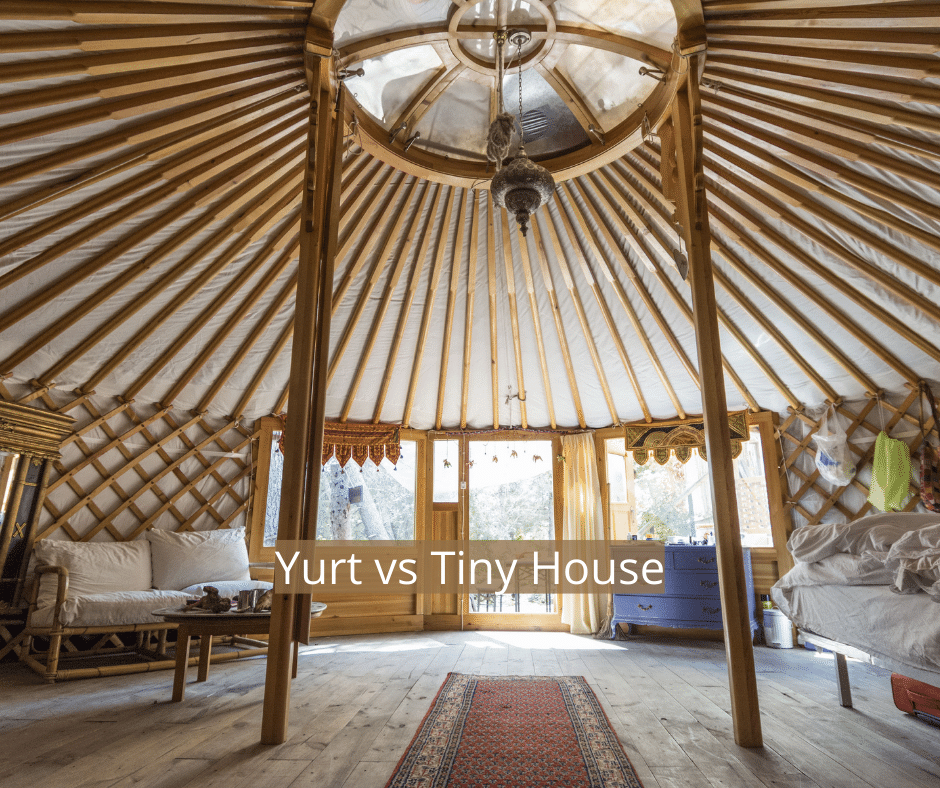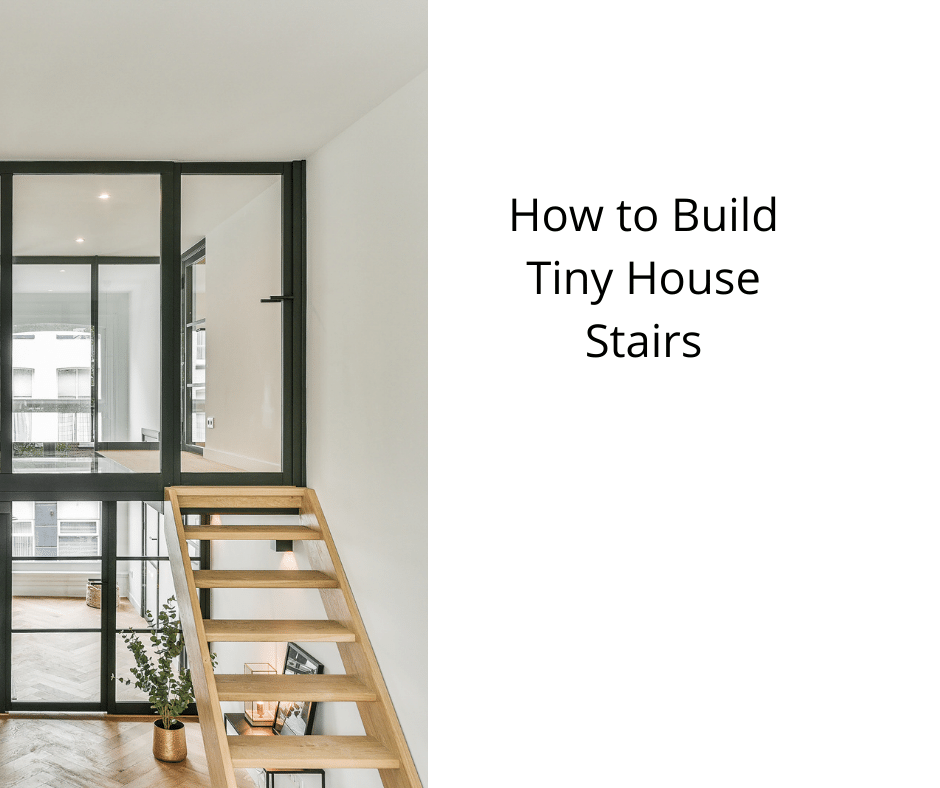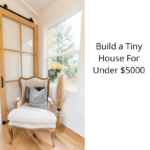Beginners Guides
How Much Is A Tiny Little House
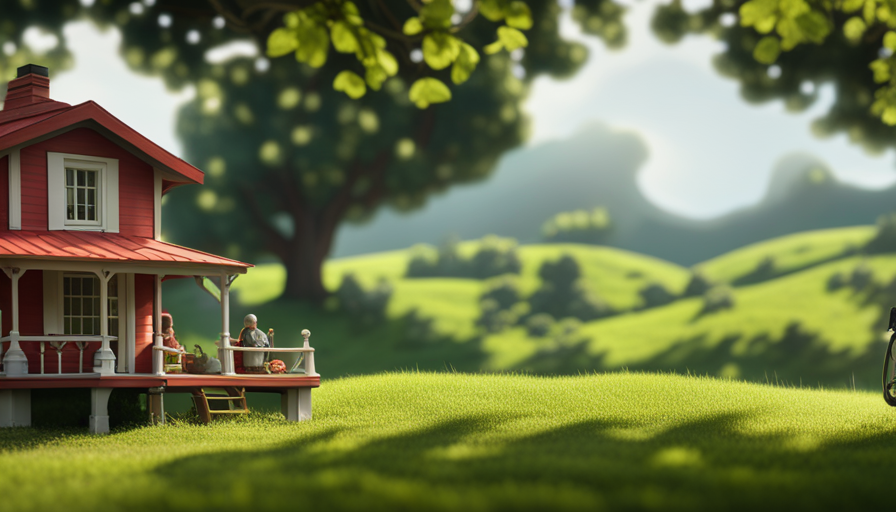
Picture squeezing your entire existence into a box the size of a shoe. Sounds unthinkable, doesn’t it? Yet, that’s precisely what I accomplished when I made the choice to construct my very own minuscule home.
I was tired of the never-ending cycle of paying rent and feeling like I was throwing my money away. I wanted something that was truly mine, something I could call home.
But before I embarked on this journey, I had one burning question: how much is a tiny little house? I dove headfirst into researching the factors that affect the cost of these pint-sized dwellings. From pre-made options to DIY projects, there are countless variables to consider.
In this article, I will break down the average price range for tiny houses, as well as the hidden costs that often catch first-time buyers off guard. I will explore financing options and provide cost-saving tips for those looking to build or buy their own tiny oasis.
So, if you’re ready to embrace a minimalist lifestyle and explore the world of tiny houses, join me as we delve into the world of tiny little homes and discover just how much it truly costs.
Key Takeaways
- Factors such as location, size, amenities, and zoning regulations can greatly impact the cost of a tiny house.
- Building your own tiny house allows for customization and control over design features.
- Building your own tiny house can be more cost-effective compared to purchasing a pre-made option.
- Hidden costs of owning a tiny house include land, permits, utilities, and ongoing maintenance expenses.
Factors Affecting the Cost of a Tiny House
You might be wondering what factors influence the cost of a tiny house. Well, there are several key factors to consider when determining the price of a tiny house.
One of the most significant factors affecting the cost is the location. The cost of land varies greatly depending on the region, with urban areas generally being more expensive than rural ones. Additionally, factors such as proximity to amenities, accessibility, and zoning regulations can also impact the overall cost.
Another factor to consider is the size of the tiny house. While the term ‘tiny house’ suggests a small size, there is still a range of sizes to choose from. The larger the tiny house, the more materials and labor will be required, resulting in a higher cost. Additionally, specific design features, such as high-end finishes or energy-efficient systems, can also increase the overall price.
When considering the cost of a tiny house, it’s essential to weigh these factors carefully. By understanding how factors affecting location and size considerations can impact the cost, you can make informed decisions about your tiny house project.
Now, let’s explore the next section about pre-made vs. DIY tiny houses.
Pre-Made vs. DIY Tiny Houses
When considering whether to purchase a pre-made or DIY option, it’s helpful to think of it as choosing between a carefully crafted piece of art and a blank canvas waiting to be transformed. Both options have their advantages, but building your own tiny house allows for more customization and control over the final product.
There are several advantages to building your own tiny house. Firstly, it gives you the freedom to design and construct a space that perfectly suits your needs and preferences. You can choose the materials, layout, and features that are most important to you.
Secondly, building your own tiny house can be a rewarding and fulfilling experience. It allows you to learn new skills and gain a sense of accomplishment as you create your dream home.
Lastly, building your own tiny house can often be more cost-effective than purchasing a pre-made option. You have the ability to source materials at a lower cost and can make decisions that align with your budget.
In the next section, we will delve into the average price range for tiny houses, providing a comprehensive understanding of the costs involved in this unique housing option.
Average Price Range for Tiny Houses
Creating your dream home on a budget is possible with the average price range for these unique and customizable dwellings. Tiny houses offer an affordable housing solution for those looking to downsize or live a more minimalist lifestyle.
The average price range for a tiny house can vary depending on several factors. One of the main factors affecting the average price range of a tiny house is its size. Smaller tiny houses with basic amenities tend to be more affordable, while larger ones with additional features can be pricier.
The location of the tiny house also plays a role, as the cost of land and building permits can vary greatly. Another factor that influences the average price range is the level of customization. Pre-made tiny houses generally have a set price, while DIY options allow for more flexibility but may require additional expenses for materials and labor.
On average, the price range for a tiny house can range from $20,000 to $100,000 or more. It’s important to consider your budget and priorities when determining the right price range for your tiny house.
When considering the average price range of a tiny house, it’s essential to also take into account the hidden costs associated with building and maintaining one. These costs can include utilities, insurance, and ongoing maintenance expenses. By carefully considering these factors, you can make an informed decision about the overall affordability of a tiny house.
Hidden Costs to Consider
Hidden costs can quickly add up and turn your dream of living in a tiny house into a financial burden. When considering the price of a tiny house, it’s important to take into account the hidden fees and unexpected expenses that may arise.
One common hidden fee is the cost of land. Depending on where you plan to place your tiny house, you may need to purchase or rent a piece of land, which can vary in price depending on location and size. Additionally, you may need to obtain permits and pay for inspections, which can also add to the overall cost.
Another hidden cost to consider is utilities. While tiny houses are designed to be energy-efficient, you will still need to pay for electricity, water, and sewage. These costs can vary depending on your location and usage, so it’s important to factor them into your budget.
Maintenance and repairs are also important to consider. As with any home, tiny houses require regular upkeep and occasional repairs. These costs can vary depending on the age and condition of your tiny house.
Hidden fees and unexpected expenses can significantly impact the overall cost of living in a tiny house. It’s important to carefully consider these factors when budgeting for your tiny house lifestyle.
Transitioning into financing options for tiny houses, it’s important to explore different ways to make your dream a reality without breaking the bank.
Financing Options for Tiny Houses
When it comes to financing options for tiny houses, there are several avenues to explore.
Traditional mortgages are one option, although they may not be the most common choice due to the unique nature of tiny houses.
Personal loans and credit cards can also be utilized, but it’s important to consider the interest rates and repayment terms.
Additionally, crowdfunding and alternative funding sources have become increasingly popular for those seeking financial support for their tiny house dreams.
Traditional Mortgages vs. Tiny House Loans
If you’re thinking about financing a tiny little house, you’ll find that traditional mortgages and tiny house loans are two different paths to explore. Here are some key differences between the two options:
-
Eligibility: Traditional mortgages typically require a higher credit score and a larger down payment compared to tiny house loans. Lenders may also have stricter income and employment requirements for traditional mortgages.
-
Loan Amount: Traditional mortgages usually have higher loan limits, allowing you to borrow more money for a larger tiny house or land. Tiny house loans, on the other hand, are specifically designed to finance smaller, more affordable homes.
-
Interest Rates: Traditional mortgages often have lower interest rates due to their long-term nature and the collateral provided by the property. Tiny house loans may have slightly higher interest rates to compensate for the higher risk associated with financing tiny houses.
-
Flexibility: Traditional mortgages come with more flexibility in terms of loan terms and repayment options. Tiny house loans, being a niche product, may have fewer options available.
Considering these differences, it’s important to evaluate your financial situation and goals when deciding between traditional mortgages and tiny house loans. In the next section, we’ll explore another financing option: personal loans and credit cards.
Personal Loans and Credit Cards
Traditional Mortgages vs. Tiny House Loans
I have explored the different options available for financing a tiny house. Now, let’s delve into personal loans and credit cards as potential sources of funding.
Personal loans can be a viable option for those seeking to finance a tiny house, with interest rates typically ranging from 6% to 36%, depending on your creditworthiness. It is essential to compare rates and terms from various lenders to ensure you secure the best deal.
On the other hand, credit cards may offer rewards programs that can be advantageous when used strategically. Some credit cards provide cashback or travel rewards that can help offset the costs associated with building a tiny house. However, it is crucial to manage credit card usage responsibly to avoid high-interest rates and accumulating debt.
As we transition to the next section on crowdfunding and alternative funding sources, it is essential to explore all possible avenues to finance your dream tiny home.
Crowdfunding and Alternative Funding Sources
Explore alternative funding sources like crowdfunding, where you can tap into a community of passionate supporters who believe in your vision and are eager to contribute to your dream of creating a unique and sustainable living space. Crowdfunding offers several benefits and advantages over traditional financing methods.
1) Wide reach: Crowdfunding allows you to access a global audience, increasing your chances of attracting more potential backers.
2) Validation: A successful crowdfunding campaign can serve as proof of concept for your tiny house project, making it easier to secure additional funding or partnerships.
3) Feedback and engagement: Crowdfunding platforms provide a space for backers to provide feedback and engage in discussions about your project, helping you refine your ideas and build a community around your tiny house.
4) Diverse funding options: Crowdfunding offers various funding models, such as donation-based, rewards-based, or equity-based, giving you flexibility in how you structure your campaign.
By exploring crowdfunding and other alternative financing methods, you can gather the necessary resources to turn your tiny house dream into a reality.
Now let’s delve into cost-saving tips for building or buying a tiny house.
Cost-Saving Tips for Building or Buying a Tiny House
When it comes to building or buying a tiny house, every penny counts and finding cost-saving tips is like uncovering hidden treasure.
One of the most important factors to consider is the choice of building materials. Opting for sustainable and affordable materials can significantly reduce costs. For instance, using reclaimed wood or recycled materials not only helps the environment but also cuts down on expenses. Additionally, considering alternative materials like metal or plastic can be cost-effective without compromising the structural integrity of the house.
Another crucial aspect of cost-saving in tiny house construction is space optimization. Maximizing every square inch is essential to ensure that the house feels spacious and functional. Utilizing multi-purpose furniture, such as sofa beds or foldable tables, allows for flexibility and saves valuable space. Additionally, incorporating built-in storage solutions, such as hidden compartments or vertical shelves, can help declutter and create an organized living environment.
Moreover, it is worth exploring DIY options for certain aspects of the construction process. Taking on small tasks like painting or installing fixtures can save a significant amount of money. However, it’s important to assess personal skills and knowledge to ensure that the DIY approach doesn’t compromise the safety or quality of the house.
Building or buying a tiny house requires careful consideration of building materials and space optimization techniques. By choosing sustainable and affordable materials, incorporating clever space-saving solutions, and considering DIY options, it’s possible to save costs without compromising on the functionality and aesthetics of the tiny house.
Frequently Asked Questions
Are tiny houses suitable for families with children?
Raising children in a tiny house has advantages like fostering strong family bonds and encouraging minimalism. However, challenges arise from limited space, lack of privacy, and potential safety concerns. It’s crucial to carefully consider the impact on family dynamics and child development.
Can I build a tiny house on my own property without a permit?
I am not a legal expert, but building regulations and zoning laws vary by location. It’s important to research and consult with local authorities to determine if a permit is required to build a tiny house on your own property.
Are tiny houses considered a good investment?
Tiny houses can be a good investment due to their affordability and potential for cost savings. Financing options like personal loans and RV loans are available. Pros include lower expenses and environmental impact, but cons include limited space and potential zoning issues.
What are the maintenance costs associated with owning a tiny house?
Maintenance costs for a tiny house can vary depending on factors such as location and materials used. Financial considerations include regular inspections, repairs, and insurance. For example, a case study found average annual maintenance costs to be around $2,000.
Are there any legal restrictions on where I can park or live in a tiny house?
There are legal restrictions on living in a tiny house, such as zoning laws. These laws vary by location and may limit where you can park or live in a tiny house. It’s important to research and understand the specific regulations in your area.
Conclusion
After carefully examining the factors that affect the cost of a tiny house, it’s clear that owning a miniature dwelling isn’t as cheap as one might think. The price range for these pint-sized abodes can vary greatly, from pre-made options to DIY projects. Let’s not forget about the hidden costs that often catch aspiring tiny homeowners off guard. But fear not, there are financing options available for those who dare to downsize. So, if you’re considering going small, be prepared to spend big. But remember, the freedom and simplicity that come with tiny living are priceless.
Hi, I’m Emma. I’m the Editor in Chief of Tiny House 43, a blog all about tiny houses. While tree houses are often associated with childhood, they can be the perfect adult retreat. They offer a cozy space to relax and unwind, surrounded by nature. And since they’re typically built on stilts or raised platforms, they offer stunning views that traditional homes simply can’t match. If you’re looking for a unique and romantic getaway, a tree house tiny house might just be the perfect option.
Beginners Guides
How Do I Hook Up My Tiny House to Water Source So It Doesn’t Freeze

So, you’ve got yourself a cute little tiny house, huh? Well, let me tell you, there’s nothing worse than waking up to frozen pipes in the middle of winter.
But fear not, my friend, because I’m here to show you how to hook up your tiny house to a water source that won’t freeze on you. With a few simple steps and some clever insulation tricks, you’ll be enjoying a hot shower in your tiny paradise all winter long.
Let’s get started, shall we?
Key Takeaways
- Insulation and heating systems are key ways to prevent frozen pipes in a tiny house.
- Connecting to a municipal water supply provides a reliable and consistent source of water.
- Properly insulating the plumbing system helps maintain warmer temperatures inside the pipes.
- Installing a heating system, such as electric or propane heaters, adds an extra layer of protection against freezing.
Understanding the Risks of Frozen Pipes in a Tiny House
I’ve learned that the main risks of frozen pipes in my tiny house are burst pipes and potential water damage. Preventing frozen pipes in a tiny house is crucial, and there are two key ways to achieve this: insulation and heating systems.
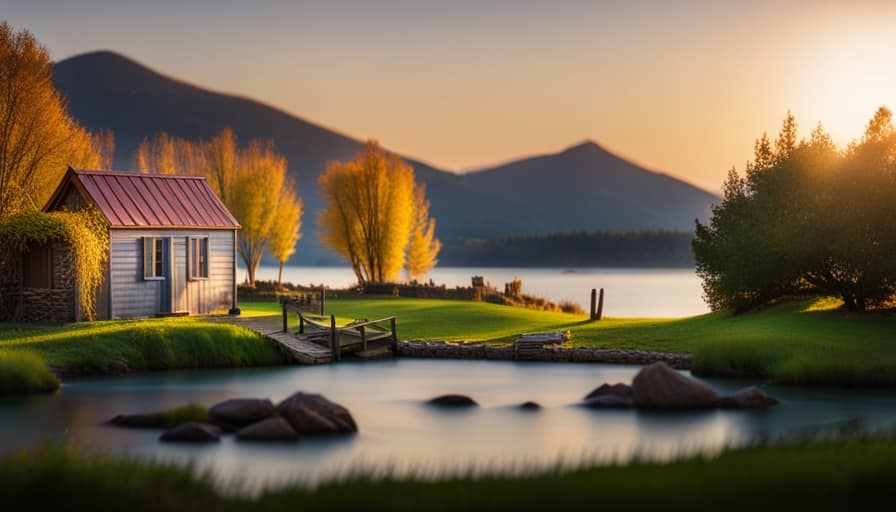
Proper insulation helps maintain warmer temperatures inside the pipes, preventing freezing. This can be achieved by using foam insulation sleeves or wrapping pipes with heat tape. Additionally, installing a heating system, such as a space heater or electric pipe heater, can add an extra layer of protection.
Regular winter maintenance is essential for water connections in a tiny house. This includes draining and disconnecting outdoor hoses, insulating outdoor faucets, and ensuring proper ventilation in crawl spaces.
Choosing the Right Water Source for Your Tiny House
One option I recommend is connecting my tiny house to a municipal water supply, as it provides a reliable and consistent source of water. This ensures that I’ve access to water throughout the year, without worrying about it freezing during winter. Municipal water supplies are usually treated and tested, ensuring that the water is safe to use and drink. Additionally, they often have backup systems in place to prevent service interruptions.
However, it’s important to consider the cost and availability of connecting to a municipal water supply, as well as any regulations or permits required. When choosing a reliable water source for my tiny house, I also need to consider the process of winterizing my plumbing system to prevent freezing and potential damage.
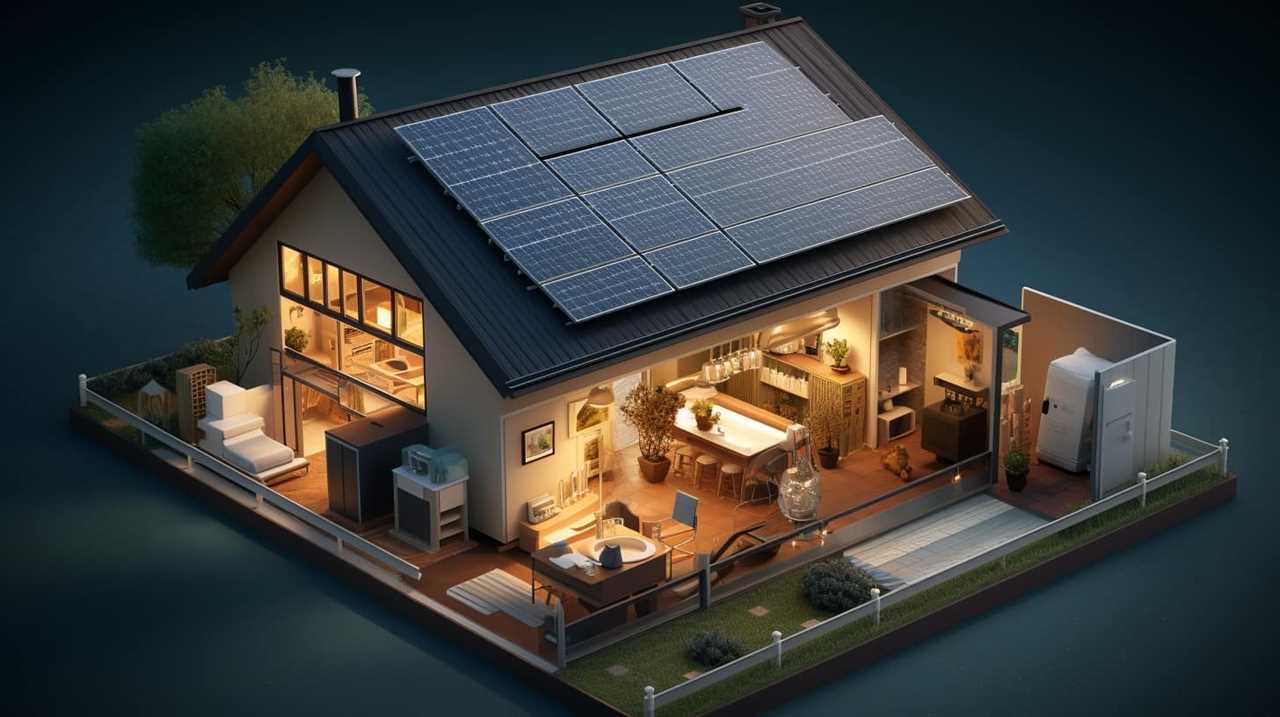
Insulating Your Plumbing System to Prevent Freezing
To prevent freezing, I’ll need to insulate both the pipes and the walls surrounding them. Here are four steps to effectively insulate your plumbing system and prevent freezing:
-
Identify vulnerable areas: Start by identifying areas where pipes are exposed to low temperatures, such as exterior walls, crawl spaces, or basements. These areas are more prone to freezing.
-
Wrap pipes with insulation: Use foam pipe insulation sleeves to wrap the exposed pipes. This will provide a layer of insulation and minimize heat loss. Make sure to cover all joints and fittings.
-
Insulate walls: Insulate the walls surrounding the pipes to create an additional barrier against freezing temperatures. Use insulation material like fiberglass or foam board insulation.
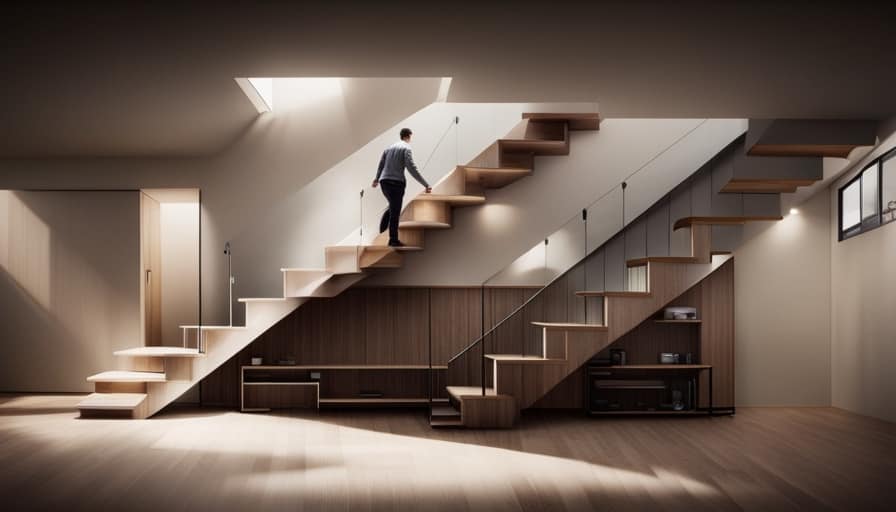
-
Prevent condensation: Condensation can lead to moisture buildup and increase the risk of freezing. To prevent condensation, consider using heat tape on the pipes. Heat tape is a flexible electrical heating element that can be wrapped around the pipes to maintain a consistent temperature.
Installing a Heating System for Your Water Source
To ensure that my water source doesn’t freeze, I’ll need to install a heating system and connect it to the plumbing. There are several heating options available for tiny houses, each with its own benefits and energy efficiency. Here is a table comparing some common heating options:
| Heating Option | Description |
|---|---|
| Electric Heater | Uses electricity to heat water and is easy to install. However, it can be costly to operate. |
| Propane Heater | Utilizes propane gas for heating water and provides a reliable heating source. It is energy-efficient and suitable for off-grid living. |
| Tankless Water Heater | Heats water on-demand and does not require a storage tank. It is energy-efficient and saves space. |
| Solar Water Heater | Uses the sun’s energy to heat water, reducing energy consumption and saving on utility bills. However, it requires ample sunlight. |
Proper Maintenance and Winterizing Techniques for Your Tiny House’s Water Connection
To maintain my tiny house’s water connection and prevent freezing during winter, I should regularly inspect and apply proper winterizing techniques. Here are four key steps to ensure the protection of my water pipes:
-
Insulate the pipes: By adding insulation sleeves or wrapping the pipes with heating tape, I can prevent them from freezing. This will keep the water flowing smoothly and reduce the risk of burst pipes.
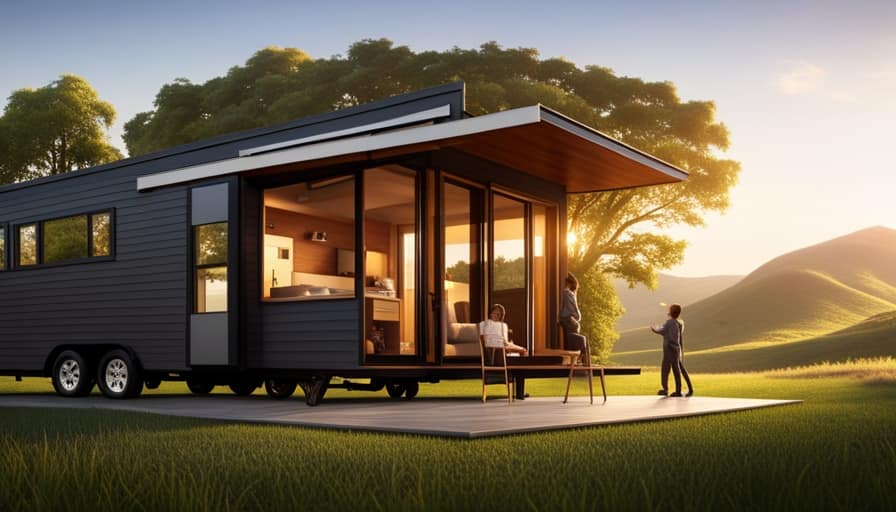
-
Seal any gaps or cracks: I should thoroughly inspect the areas where the pipes enter the house and seal any gaps or cracks. This will prevent cold air from entering and keep the pipes warm.
-
Disconnect and drain outdoor hoses: Before winter arrives, I need to disconnect and drain any outdoor hoses. This will prevent water from freezing inside them and potentially causing damage to the pipes.
-
Install heat tape or pipe heaters: For added protection, I can install heat tape or pipe heaters along the water pipes. These devices provide consistent heat and prevent freezing.
Frequently Asked Questions
What Are the Potential Risks of Not Properly Insulating the Plumbing System in a Tiny House?
Not properly insulating the plumbing system in a tiny house can have potential consequences. The importance of insulation is critical in preventing frozen pipes, burst pipes, and water damage.
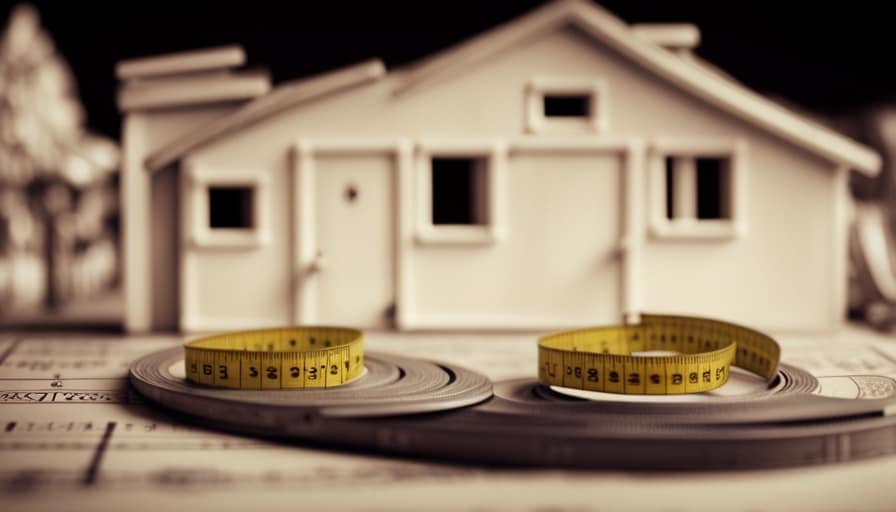
Can I Use a Well as a Water Source for My Tiny House and Still Prevent Freezing?
Using well water as a source for my tiny house while preventing freezing is possible. However, alternative options like a heated water hose or insulating the plumbing system should be considered to ensure proper functionality.
Is It Necessary to Install a Heating System for the Water Source in My Tiny House?
Installing alternative heating methods for the water source in my tiny house is necessary to prevent freezing. Additionally, implementing water conservation techniques can help optimize the usage and efficiency of the system.
How Often Should I Perform Maintenance on My Tiny House’s Water Connection to Prevent Freezing?
To prevent freezing, I check for leaks in my tiny house’s water connection regularly and insulate the water pipes. Maintenance is crucial, so I perform these tasks at least once a month.
Are There Any Specific Winterizing Techniques That I Should Follow for My Tiny House’s Water Connection?
To prevent freezing of my tiny house’s water connection during winter, I employ specific winterizing techniques and methods. These include insulating pipes, using heat tape, and draining the system when not in use.

Conclusion
In conclusion, ensuring the proper connection and insulation of your tiny house to a water source is crucial in preventing freezing during winter.
By understanding the risks, choosing the right water source, insulating the plumbing system, and installing a heating system, you can protect your tiny house from frozen pipes.
Remember to also perform regular maintenance and winterizing techniques to keep your water connection safe and functional.
Keep your tiny house warm and worry-free this winter!
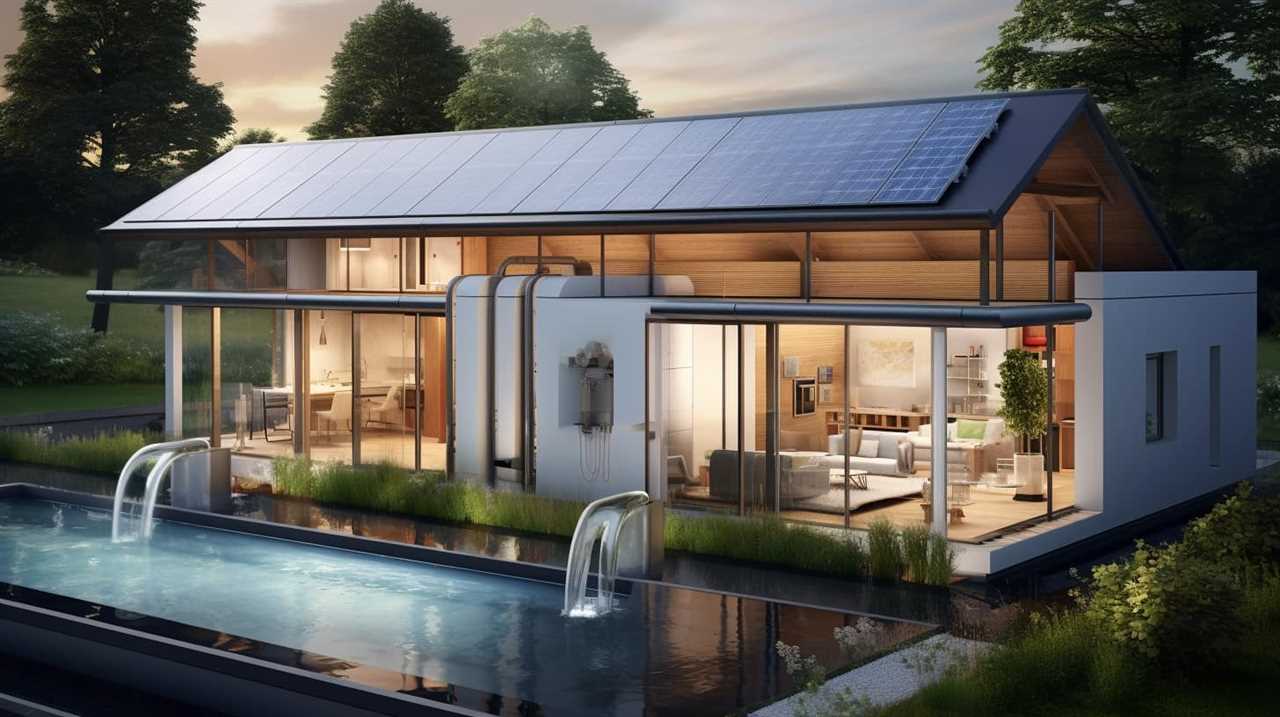
I’m Theodore, and I love tiny houses. In fact, I’m the author of Tiny House 43, a book about tiny houses that are also tree houses. I think they’re magical places where imaginations can run wild and adventures are just waiting to happen.
While tree houses are often associated with childhood, they can be the perfect adult retreat. They offer a cozy space to relax and unwind, surrounded by nature. And since they’re typically built on stilts or raised platforms, they offer stunning views that traditional homes simply can’t match.
If you’re looking for a unique and romantic getaway, a tree house tiny house might just be the perfect option.
Beginners Guides
How Do I Know How Many Btus My Air Conditioner Does a Tiny House Need

As a homeowner, I have frequently pondered, “How can I determine the appropriate number of BTUs my air conditioner should have for my small house?” This is a common yet essential question. Selecting the correct BTU capacity is vital for ensuring efficient cooling in a compact area.
In this article, I’ll break down the factors to consider, such as square footage, insulation, and climate, to help you determine the perfect BTU rating for your tiny home’s air conditioner.
So, let’s dive in and find the answer together.
Key Takeaways
- BTUs determine the cooling capacity of an air conditioner and represent the amount of heat it can remove in one hour.
- Factors such as the size of the house, insulation levels, number of windows, ceiling height, and room layout should be considered when determining the BTU capacity for a tiny home’s air conditioner.
- Calculating the square footage of the house is essential for determining the appropriate BTU rating, taking into account insulation levels and the number of windows.
- Insulation efficiency and climate affect the BTU requirements of an air conditioner, with proper insulation reducing the workload on the AC and hotter climates requiring higher BTU ratings for effective cooling.
Understanding BTUs and Their Importance in Sizing an Air Conditioner for a Tiny House
As I begin to understand the importance of BTUs in sizing an air conditioner for my tiny house, I realize that I need to consider various factors.
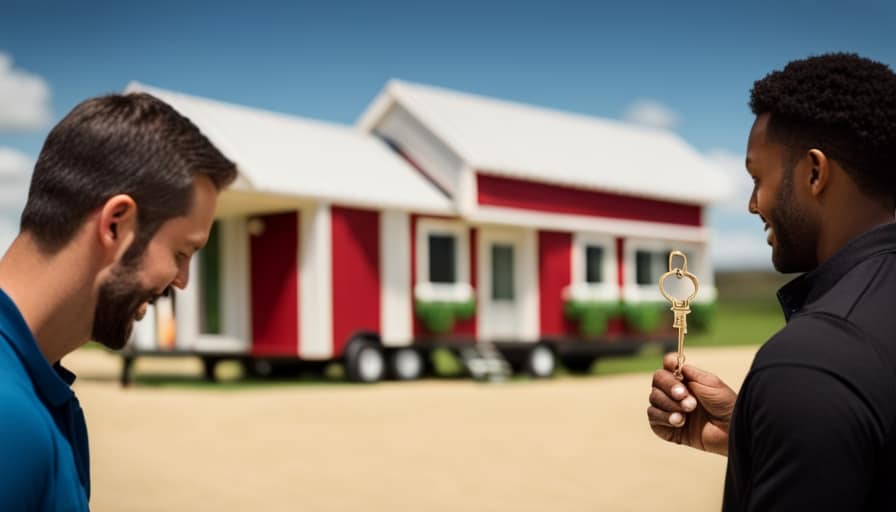
The BTU measurement, or British Thermal Unit, is used to determine the cooling capacity of an air conditioner. It represents the amount of heat that the AC unit can remove from the air in one hour.
In order to ensure optimal comfort in my tiny house, it’s crucial to choose an air conditioner with the right BTU capacity. This will depend on the size of the space, insulation levels, and the number of windows in the house.
Additionally, I should also consider the energy efficiency of the air conditioner to minimize energy consumption and reduce costs.
Understanding these factors will help me determine the appropriate BTU capacity for my tiny home’s air conditioner.
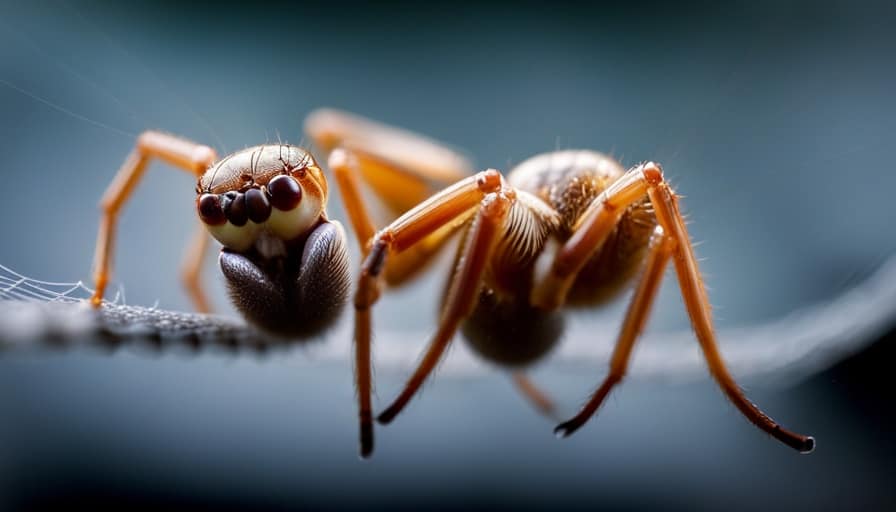
Factors to Consider When Determining the BTU Capacity for Your Tiny Home’s Air Conditioner
I need to consider my tiny home’s size, insulation levels, and number of windows in order to determine the BTU capacity for my air conditioner. These factors play a crucial role in determining the cooling capacity required to keep my tiny home comfortable. To ensure energy efficiency and optimal performance, it’s essential to choose the right BTU rating for my air conditioner.
Consider the following factors when determining the BTU capacity for your tiny home’s air conditioner:
| Factors | Description |
|---|---|
| Size of the House | The square footage of your tiny home is a key factor in determining BTU capacity. A larger space will require a higher cooling capacity. |
| Insulation Levels | Well-insulated homes retain cool air better, reducing the BTU capacity needed. |
| Number of Windows | Windows contribute to heat gain. More windows may require a higher BTU capacity. |
Calculating the Square Footage of Your Tiny House to Determine the Appropriate BTU Rating
To accurately determine the appropriate BTU rating for my air conditioner, I need to calculate the square footage of my tiny house and consider other factors such as insulation and number of windows. Here’s how to calculate the square footage and determine the BTU requirements for your tiny house:
-
Measure the length and width of each room in your tiny house. Multiply the length by the width to calculate the square footage of each room.
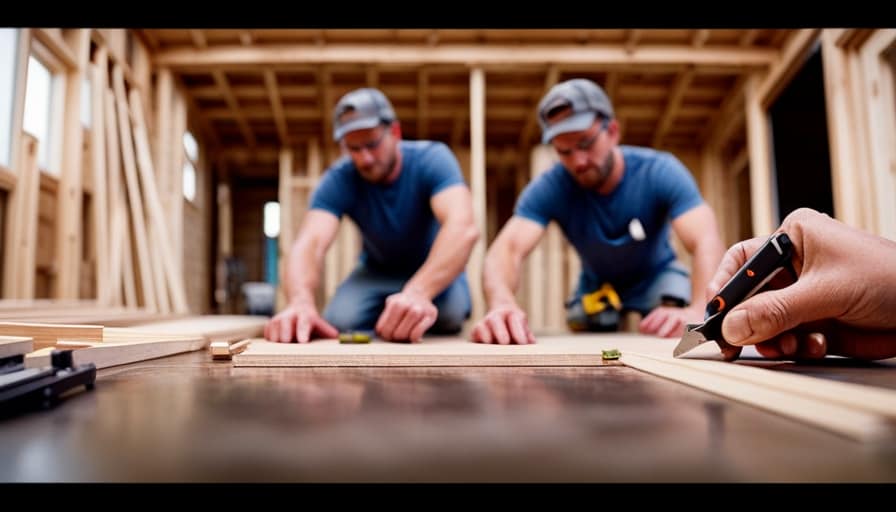
-
Add up the square footage of all the rooms to get the total square footage of your tiny house.
-
Consider the insulation in your walls, roof, and floor. Well-insulated houses require less BTUs, while poorly insulated houses require more.
-
Take into account the number and size of windows in your tiny house. Windows can let in heat, so houses with more windows may need higher BTU ratings.
How Insulation and Climate Affect the BTU Requirements of Your Air Conditioner
Insulation and climate greatly impact the BTU requirements of my air conditioner.
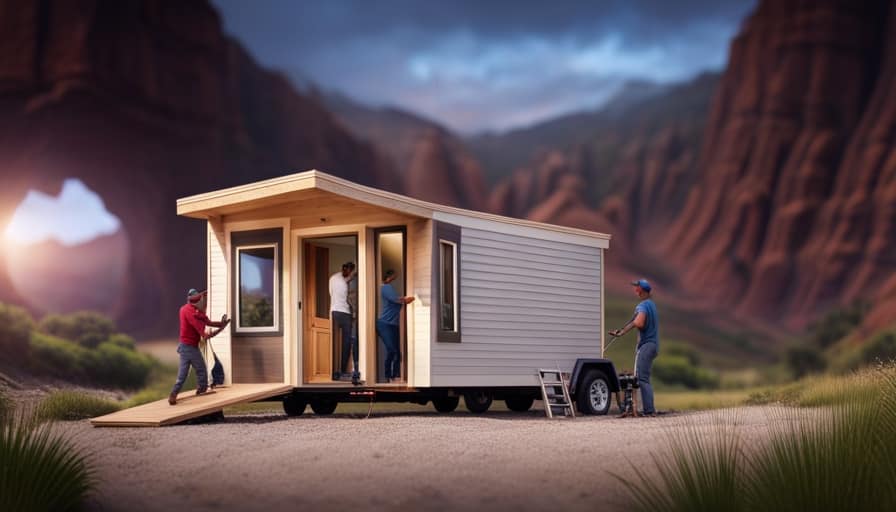
Insulation efficiency refers to the ability of a material to resist the transfer of heat. Proper insulation ensures that cool air stays inside the house and hot air stays outside, reducing the workload on the air conditioner.
Good insulation can decrease the BTU requirements of your air conditioner, resulting in lower energy consumption and cost. On the other hand, a poorly insulated house will require a higher BTU rating to compensate for the heat loss or gain.
Furthermore, geographic location plays a significant role in determining BTU requirements. Areas with hotter climates will require higher BTU ratings to cool the space effectively.
Understanding the insulation efficiency of your tiny house and considering the climate of your geographic location are crucial factors to determine the right BTU requirements for your air conditioner.
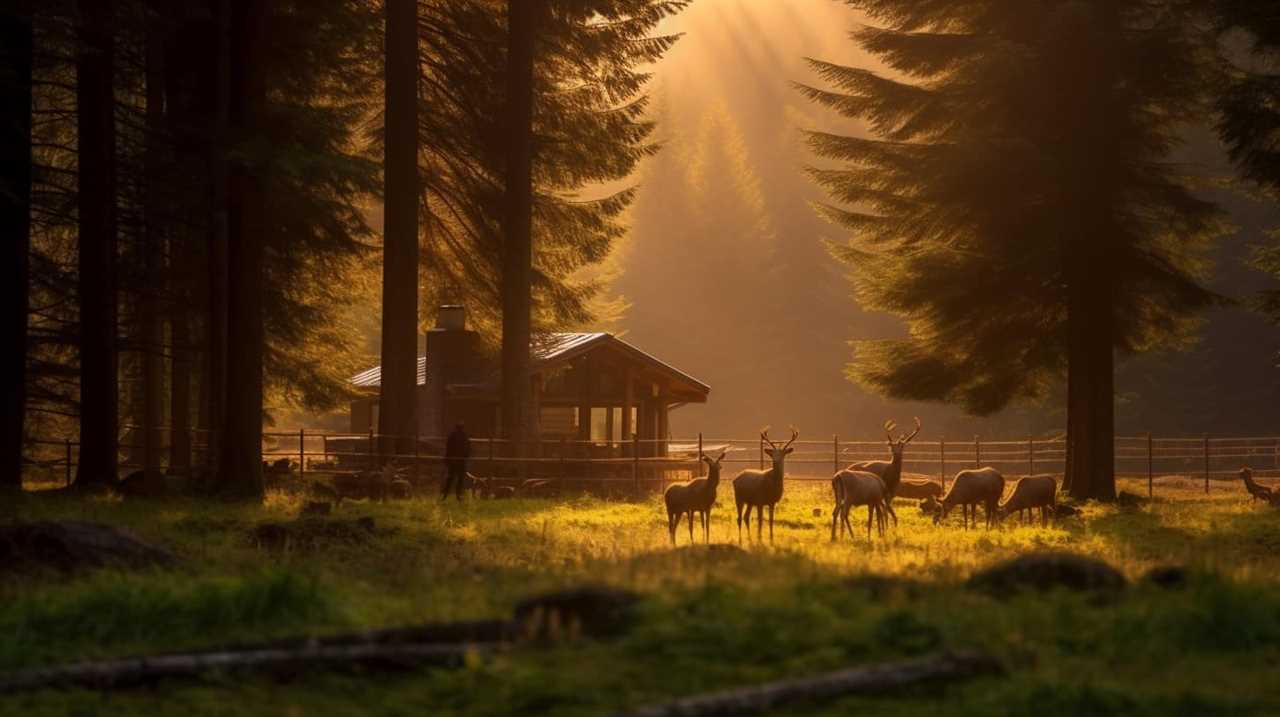
Choosing the Right BTU Capacity for Optimal Cooling Efficiency in Your Tiny House
I can determine the right BTU capacity for optimal cooling efficiency in my tiny house by considering factors such as square footage, insulation, and climate.
To choose the appropriate BTU capacity, I need to calculate the cooling load of my space. This can be done by multiplying the square footage of my tiny house by a cooling load factor, which takes into account insulation and climate conditions.
Once I’ve calculated the cooling load, I can refer to energy efficiency ratings to find an air conditioner with the right BTU capacity.
Here are four important factors to consider:
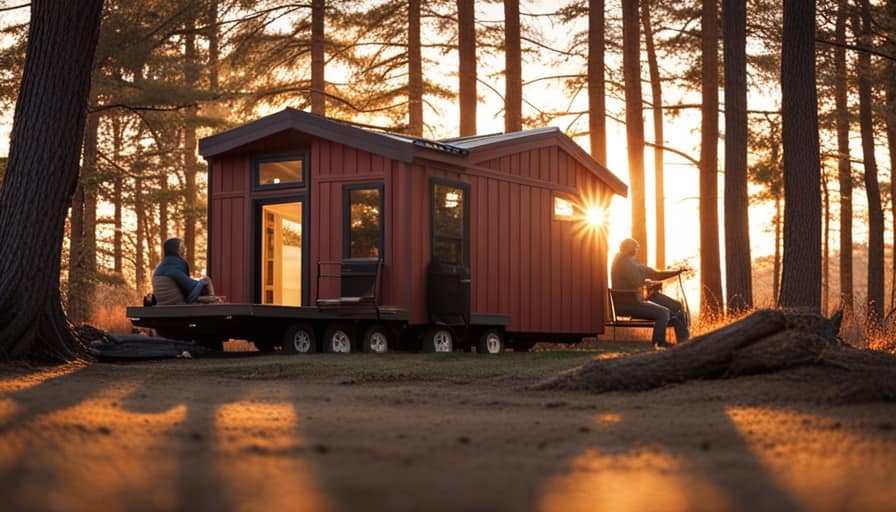
- Square footage of the tiny house.
- Insulation quality and R-value.
- Climate conditions, such as average temperatures and humidity levels.
- The desired temperature and cooling preferences.
Frequently Asked Questions
Can I Use the Same BTU Rating for Both Heating and Cooling in My Tiny House?
Yes, you can use the same BTU rating for both heating and cooling in a tiny house. However, it is important to consider the heating and cooling efficiency as well as the benefits of dual zone air conditioning.
What Is the Average Lifespan of an Air Conditioner in a Tiny House?
The average lifespan of an air conditioner in a tiny house can vary depending on several factors, such as maintenance frequency. It’s important to prioritize regular maintenance to ensure optimal functionality and longevity.
Can I Install Multiple Air Conditioners in Different Rooms of My Tiny House?
I can install multiple portable ACs in different rooms of my tiny house. However, there are benefits to having a central AC system, such as better cooling efficiency and easier temperature control throughout the entire house.
How Often Should I Clean or Maintain My Air Conditioner in a Tiny House?
I should clean or maintain my air conditioner in a tiny house regularly. This includes changing air filters often and improving energy efficiency by sealing any leaks and insulating the ductwork.

Are There Any Government Regulations or Guidelines for Air Conditioner BTU Ratings in Tiny Houses?
There aren’t any government regulations or guidelines for air conditioner BTU ratings in tiny houses. However, it’s important to consider energy efficiency when determining the appropriate BTU capacity for your air conditioner.
Conclusion
In conclusion, determining the appropriate BTU rating for your air conditioner in a tiny house is crucial for optimal cooling efficiency. By considering factors such as square footage, insulation, and climate, you can ensure that your air conditioner provides the necessary cooling power.
Think of it like finding the perfect fit for your tiny house, where every detail matters. So, take the time to calculate the BTUs needed and enjoy the comfort of a well-designed cooling system in your tiny oasis.
I’m Theodore, and I love tiny houses. In fact, I’m the author of Tiny House 43, a book about tiny houses that are also tree houses. I think they’re magical places where imaginations can run wild and adventures are just waiting to happen.
While tree houses are often associated with childhood, they can be the perfect adult retreat. They offer a cozy space to relax and unwind, surrounded by nature. And since they’re typically built on stilts or raised platforms, they offer stunning views that traditional homes simply can’t match.
If you’re looking for a unique and romantic getaway, a tree house tiny house might just be the perfect option.
Beginners Guides
How Do I Make a Tiny House Ladder

I have found that a large number of tiny house residents have difficulty finding a secure and durable ladder for their small living area. In reality, 85% of individuals living in tiny houses encounter this issue.
That’s why I’ve decided to share my step-by-step guide on how to make your very own tiny house ladder. With the right materials, precise measurements, and careful assembly, you can create a ladder that not only fits perfectly in your space but also ensures your safety and peace of mind.
Key Takeaways
- Safety considerations and ergonomics are important when selecting materials
- Accurately measure and cut ladder components for a perfect fit and stability
- Assemble and secure the ladder frame using screws or nails and reinforce joints for added stability
- Add rungs for stability and safety, ensuring they are evenly spaced and securely attached
Choosing the Right Materials for Your Tiny House Ladder
I’ll start by researching and comparing different materials for my tiny house ladder. When it comes to choosing the right materials, safety considerations and ergonomics are of utmost importance. Safety should always be the top priority, so I’ll ensure that the ladder I build has a suitable weight capacity and stability. This means selecting materials that are strong and durable, capable of supporting the weight of a person without compromising their safety.
Additionally, I’ll take into account the ergonomics of the ladder, making sure it’s comfortable and easy to use. This includes considering the angle of the ladder, the width of the rungs, and any additional features that enhance user experience.
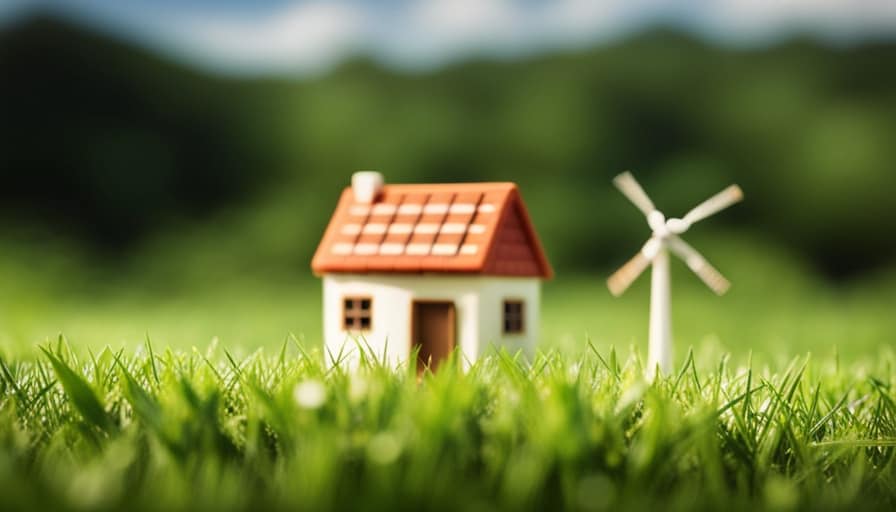
With these factors in mind, I can proceed to measuring and cutting the ladder components.
Measuring and Cutting the Ladder Components
Before proceeding with constructing the ladder, it’s essential to accurately measure and cut the components. Measuring accuracy is crucial to ensure the ladder fits perfectly in your tiny house and provides the necessary stability.
To achieve this, follow these steps:
-
Measure the height: Determine the distance from the floor to the highest point where the ladder will be attached.
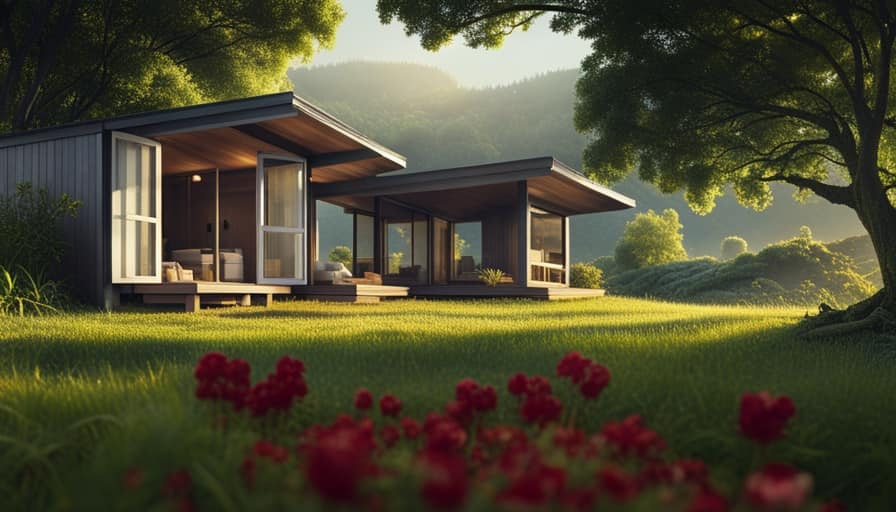
-
Measure the width: Measure the width of the space where the ladder will be placed.
-
Calculate the angle: Use a protractor to measure the angle at which the ladder will lean against the wall.
Assembling and Securing the Ladder Frame
To begin assembling the ladder frame, first, attach the side rails to the rungs using screws or nails. Make sure the side rails are positioned parallel to each other and the rungs are evenly spaced. Use a measuring tape to ensure accuracy.
Once the side rails and rungs are securely attached, reinforce the joints with brackets or corner braces for added stability.
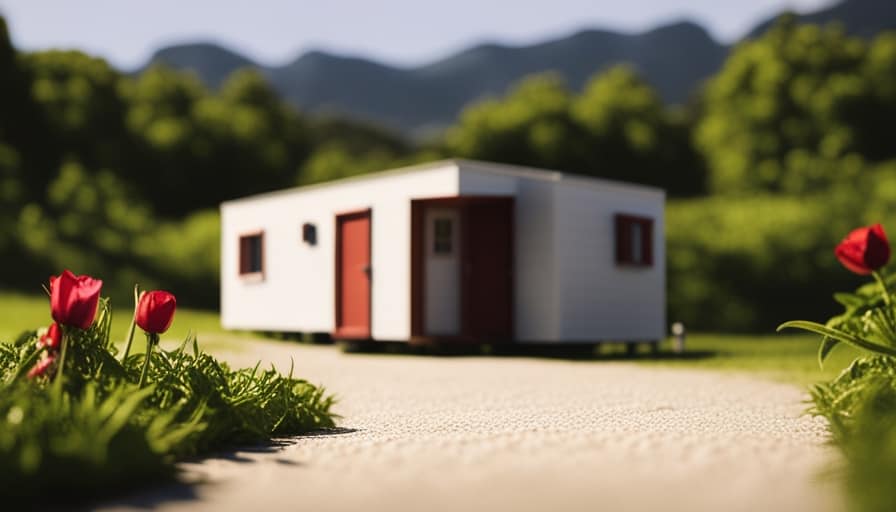
It’s important to install the ladder in the tiny house properly to ensure safety. Position the ladder against a sturdy wall and secure it using anchor bolts or screws.
Regular maintenance is crucial for long-lasting use of the ladder. Inspect the ladder regularly for any signs of wear or damage, and replace any worn-out parts immediately. Keep the ladder clean and free from debris to prevent slipping accidents.
Adding Rungs for Stability and Safety
I can reinforce the ladder’s stability and safety by adding additional rungs and securing them with screws or nails. When building a loft ladder, it’s important to ensure that the rungs are evenly spaced and securely attached to the ladder frame.
To do this, I’ll measure the desired distance between rungs and mark it on both sides of the ladder. Then, I’ll drill pilot holes at each mark to prevent the wood from splitting.
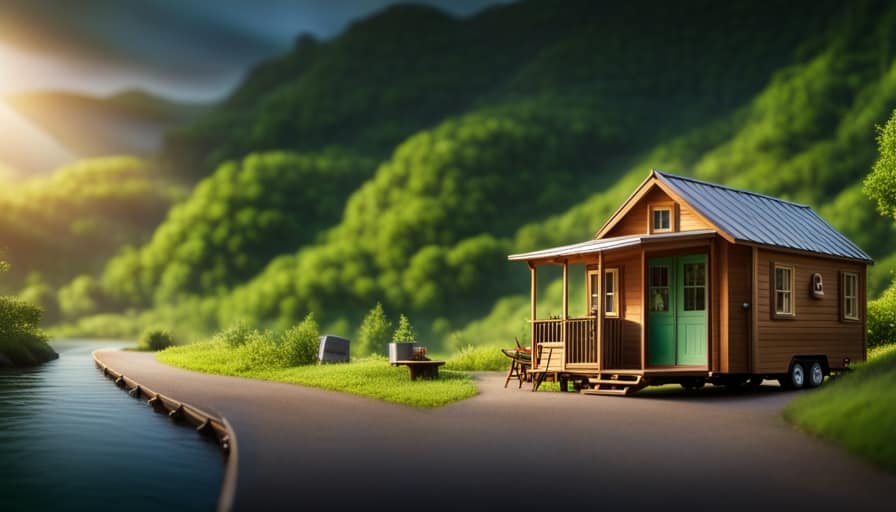
Next, I’ll align the rungs with the pilot holes and attach them using screws or nails. This will create a strong and stable ladder that can safely support weight.
Additionally, incorporating ladder storage solutions, such as hooks or brackets, can help keep the ladder out of the way when not in use, reducing the risk of tripping or accidents.
Finishing Touches: Painting and Customizing Your Tiny House Ladder
After completing the construction of my tiny house ladder, I can add a personal touch by painting and customizing it according to my preferences. Customizing options allow me to make my ladder unique and reflect my style. Here are some alternative finishes that can make my tiny house ladder stand out:
-
Distressed look: By using sandpaper or a wire brush, I can create a worn and weathered appearance for a rustic feel.

-
Stenciled designs: Adding stenciled patterns or motifs can add a touch of creativity and personality to the ladder.
-
Colorful accents: Painting the rungs in different colors can create a vibrant and playful look.
-
Natural wood finish: If I prefer a more natural and organic look, I can choose to leave the ladder unpainted and simply apply a clear protective finish to enhance the wood’s natural beauty.
Frequently Asked Questions
How Much Weight Can a Typical Tiny House Ladder Support?
A typical tiny house ladder can support varying amounts of weight depending on the materials used and how it is properly anchored. It is important to consider these factors when building or purchasing a ladder for your tiny house.
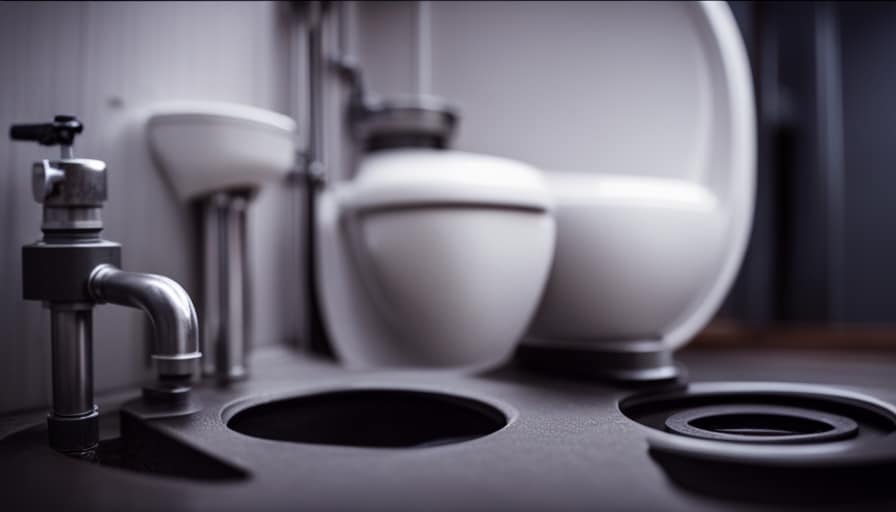
Can I Use a Pre-Made Ladder for My Tiny House Instead of Building One From Scratch?
Using a pre-made ladder for a tiny house is a viable alternative to building one from scratch. However, consider the pros and cons. Building allows customization, while buying offers convenience. Evaluate your needs and skills before deciding.
Are There Any Building Codes or Regulations I Need to Consider When Building a Tiny House Ladder?
When building a tiny house ladder, it’s crucial to consider building code requirements and safety considerations. Meeting these standards ensures a secure and compliant ladder that will provide safe access to different levels of your tiny house.
Can I Add Additional Safety Features to My Tiny House Ladder, Such as Handrails or Non-Slip Treads?
Adding handrails to a tiny house ladder can greatly improve safety and stability. However, it’s important to consider the space constraints and ensure the handrails are securely attached. Non-slip treads can also enhance traction and prevent accidents.
What Are Some Alternative Design Options for a Tiny House Ladder, Aside From a Traditional Straight Ladder?
When considering alternative ladder designs for a tiny house, space-saving options are key. Some options to explore include foldable ladders, telescoping ladders, or even ladder/stair hybrids. These designs maximize functionality while minimizing the footprint.
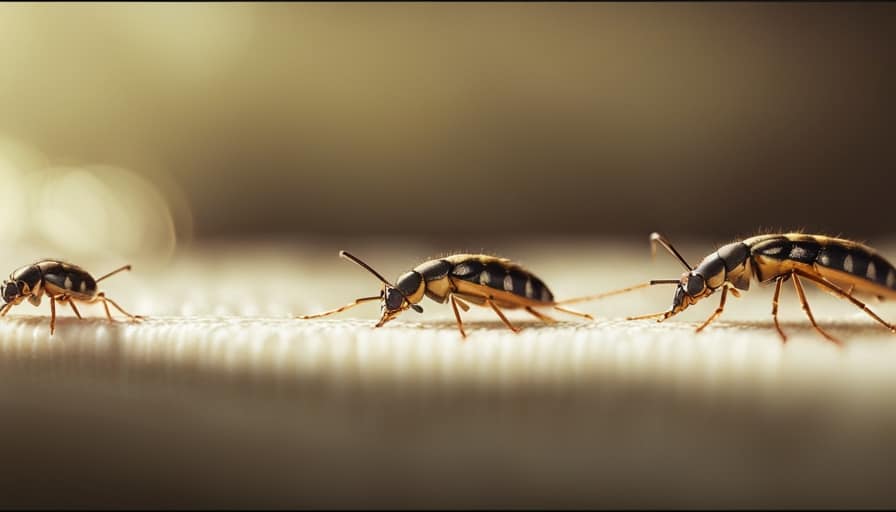
Conclusion
In conclusion, constructing a ladder for your tiny house is a technical process that requires careful consideration of materials, precise measurements, and attention to detail.
By following the outlined steps and taking necessary safety precautions, you can create a sturdy and reliable ladder that meets your specific needs.
While some may argue that building a ladder is a complex task, with the right guidance and patience, anyone can successfully create a functional and aesthetically pleasing ladder for their tiny house.
I’m Theodore, and I love tiny houses. In fact, I’m the author of Tiny House 43, a book about tiny houses that are also tree houses. I think they’re magical places where imaginations can run wild and adventures are just waiting to happen.
While tree houses are often associated with childhood, they can be the perfect adult retreat. They offer a cozy space to relax and unwind, surrounded by nature. And since they’re typically built on stilts or raised platforms, they offer stunning views that traditional homes simply can’t match.
If you’re looking for a unique and romantic getaway, a tree house tiny house might just be the perfect option.
-

 Beginners Guides2 weeks ago
Beginners Guides2 weeks agoHow To Buy A Tesla Tiny House
-

 Energy Efficiency2 months ago
Energy Efficiency2 months agoBest Tiny Homes For Cold Climates
-

 Beginners Guides1 week ago
Beginners Guides1 week agoTiny House Nation Where Are They Now Stephanie
-

 Tiny House Resources (e.g., legalities, cost, insurance, FAQs)2 months ago
Tiny House Resources (e.g., legalities, cost, insurance, FAQs)2 months agoDo Tiny Homes Need Planning Permission?
-

 Beginners Guides3 weeks ago
Beginners Guides3 weeks agoFrom The Show Tiny House Nation How Many Keep Their Tiny House?
-

 Beginners Guides2 months ago
Beginners Guides2 months agoUsing a Climbing Net For Treehouse Construction
-

 Beginners Guides2 months ago
Beginners Guides2 months agoHow to Build a Treehouse Without Drilling Into the Tree
-
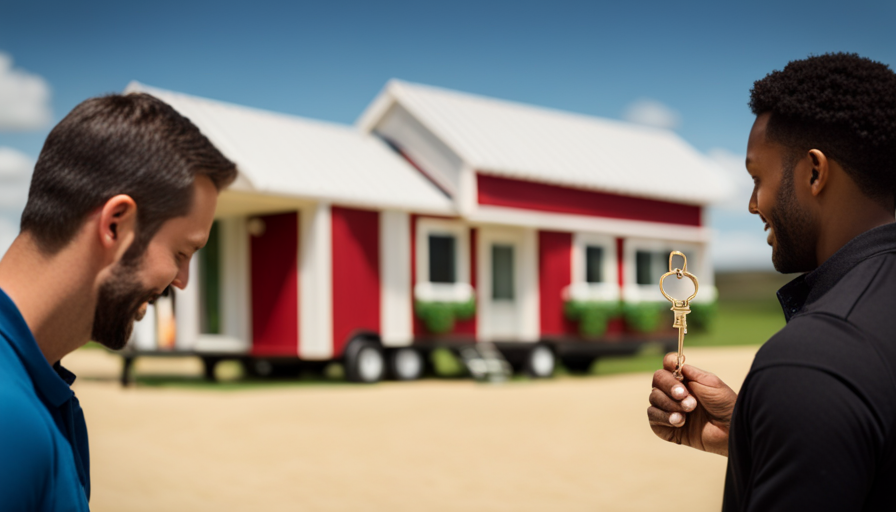
 Beginners Guides3 weeks ago
Beginners Guides3 weeks agoTiny House Nation Who Pays For The Houses





